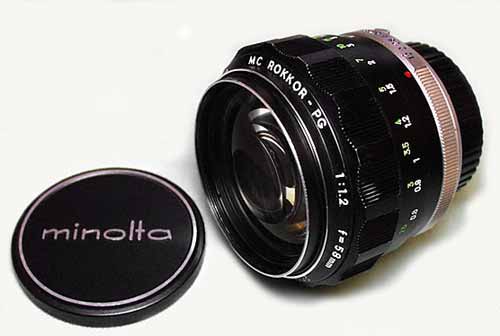These
two categories have been joined together, as they are principally the
same, except in a minor cosmetic issue. The main changes implemented in
the Typical MC Rokkor Series was the introduction of a rubber focusing
ring, as opposed to the previous milled metal ring. This was accompanied
by a complete redesign of the cosmetic appearance of the lenses, including
the replacement of the white metal aperture ring with a black painted
ring. As a general rule, coatings were improved from the earlier MC series,
but the optical formulas were generally unchanged. In fact, the coatings
on these lenses were progressively improved throughout their life, and
the later MC models are understood to have coatings very similar to the
MD models.
In
line with Minolta’s practice of labeling products differently in
different markets, the lenses were labeled “Rokkor-X” in the
North American market, and “Rokkor” throughout the rest of
the world. It is noted that apart from this minor cosmetic change there
is no difference between the Rokkor and Rokkor-X version of the same lens.
The
difference between the two categories (Typical MC Rokkor and Late MC Rokkor)
is generally the discontinuation of the two letter code on the front of
the lens. This code designated the number of groups and elements within
a lens, with details as follows:
First
Letter (no. of groups): T=3; Q=4; P=5; H=6; S=7; O=8; N=9.
Second Letter (no. of elements): C=3; D=4; E=5; F=6; G=7; H=8; I=9; J=10;
K=11; L=12.
For
example, the 58mm f/1.2 MC Rokkor - PG contained 7 elements in 5 groups.
The late MC lenses (3rd MC generation) discontinued this practice.
While
the differences between the 2nd and 3rd generations were principally the
removal of the two letter lens code, some lens designs were altered during
this period. For example, the early MC lenses which featured a depth of
field preview button had this feature removed in the later designs, and
the 135mm lenses and 200mm lenses were totally redesigned during this
era. Additionally, some designs such as the 24mm f/2.8 VFC and the 17mm
f/4 were only introduced in the 3rd generation.
Coatings
on the MC 2nd and 3rd generation lenses are generally better than those
on the earlier 1st generation lenses. However, this is a generalisation
because the coatings were undergoing continual development during this
period, and accordingly the break from “old” coatings to “new”
coatings was progressive, and it is actually likely that there were multiple
improvements throughout this period. That said, by the end of the MC series
lenses, the coatings were exceptionally advanced , and consisted of multiple
layers on both surfaces of all lens elements, giving less flare, better
contrast, and rich true colours.
These
lenses are generally magnificent examples of the lens maker’s art.
With incredible build quality, even in the less expensive models, they
make an excellent choice for the keen photographer, and given they are
normally about 20% cheaper than their MD Series counterparts, they make
good financial sense as well. |

















